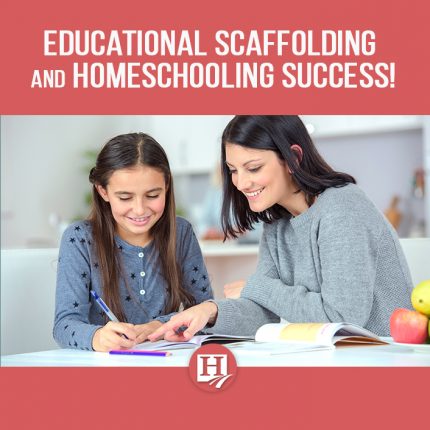
Educational Scaffolding and Homeschool Success!
December 10, 2018It’s understandable that many of us homeschool in order to remove ourselves from the “educational system.” While I agree completely with that mindset, I do believe that there are some instructional or teaching strategies that really are amazing… classroom or home!
Scaffolding is one of those teaching strategies that I really feel should have an important place in any teaching setting… including our homeschool. Scaffolding is by definition “a process through which a teacher adds supports for students in order to enhance learning and aid in the mastery of tasks. The teacher does this by systematically building on students’ experiences and knowledge as they are learning new skills. Just like the scaffold in the picture to the left, these supports are temporary and adjustable. As students master the assigned tasks, the supports are gradually removed.”1
As you can see, it just makes sense, doesn’t it? I have seen how the use of scaffolding can really make a difference! Here’s how can we intentionally incorporate scaffolding into our daily homeschooling strategy. It’s simple:
- Use visuals! When teaching your students a new concept make sure to find something that visually represents the concept. A visual could be: an illustration or drawing, a photograph, a video or film, or even a real-life object, The purpose is to help the student make connections to existing knowledge that they may have.
- Use Graphic Organizers! The use of graphic organizers is great for enabling the student to think through a concept in a systematic way. A graphic organizer could include charts, tables, graphs, concept charts, word walls etc. The key to using graphic organizers is to keep them simple!
- Make the connection! When you begin a new unit or lesson take a minute and introduce it. While you are introducing the new concept help the students to make a connection from the new idea to previously learned ideas! The essence of scaffolding! These connections can be made using a question/answer time or even an open discussion.
- Read Aloud! We all know the importance of reading aloud, but reading aloud the text or portion of text from which you will be teaching will help the students with an additional means of connecting. Don’t just leave it with reading aloud – make sure that you teach the concept and include sensory learning!
- Use modeling! Want the students to understand how to do something – show them! We can easily model procedure and other types of skills to be learned while teaching a new concept. Modeling and using hand gestures is definitely a great way to get your point across.
- Work together! Sometimes it’s best to have someone else give the teaching a shot. If your kiddos are just not getting a concept don’t stress… have an older brother jump in and work with the struggling student. It’s a homeschool family’s privilege to use group learning on a regular basis!
1. The IRIS Center Peabody College Vanderbilt University Nashville, TN 37203 https://iris.peabody.vanderbilt.edu/module/sca/cresource/q1/p01/
Jamie Gaddy
Jamie Gaddy, B.S., M.Ed., Ed.D. has been a college education professor for over 17 years. Education has been a part of her life in both the classroom and as a principal. Six children later found her dissatisfied with traditional school and homeschool became the better fit. She is also a pastor’s wife, editor, and entrepreneur who now homeschools four of her six children in Georgia. Jamie loves to share about her homeschool experience to help other homeschoolers find success. Connect with her at [email protected].
Latest Posts

Guest Post by Gabriel Morse For several years, I sat for long hours every day behind one of those battleship gray desks in a windowless, dull, gray office. The pay was enough to take care…
Read more >
This post is sponsored by Little Monsters Universe. I'm Tina Salmanowitz, an advocate for homeschooling and science education. With over a decade of experience as a science educator (in class…
Read more >
This post is sponsored by Time4Learning. Before the pandemic, it was business as usual for Boca Raton resident Nikki Warris. Her two daughters, 5-year-old Natalie and 8-year-old Lexi were…
Read more >

